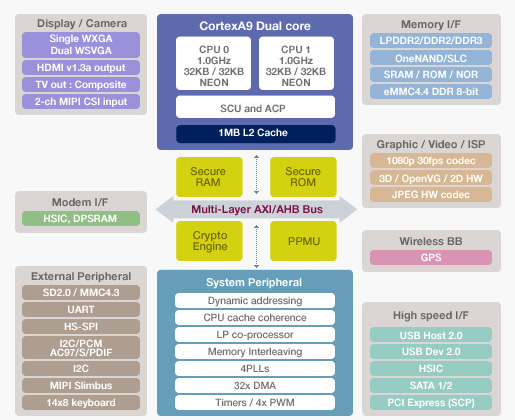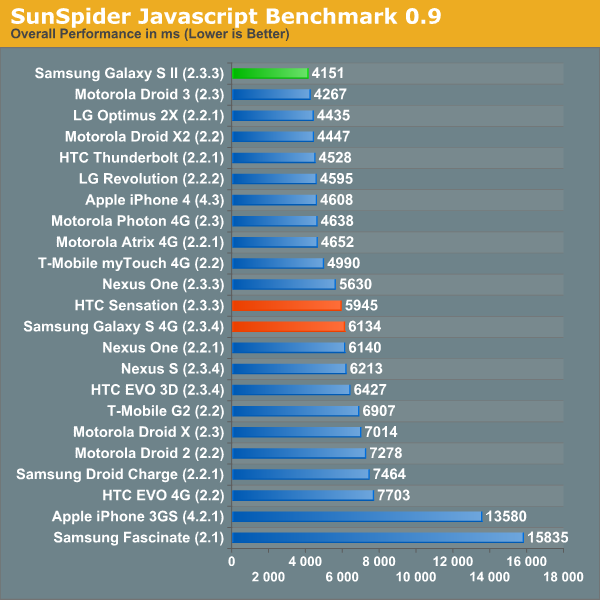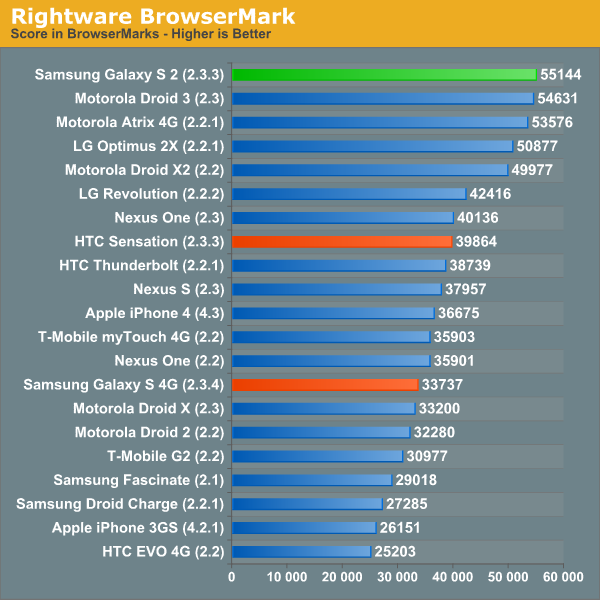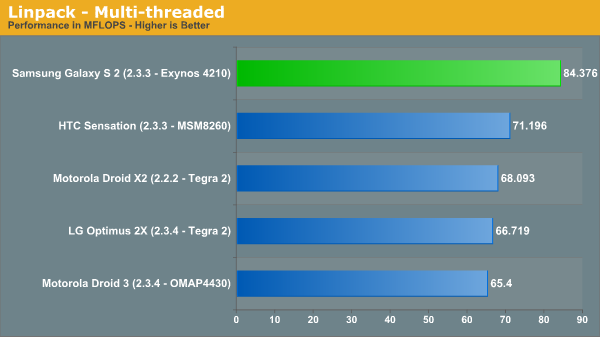Samsung Galaxy S 2 (International) Review - The Best, Redefined
by Brian Klug & Anand Lal Shimpi on September 11, 2011 11:06 AM EST- Posted in
- Smartphones
- Samsung
- Galaxy S II
- Exynos
- Mobile
The Fastest Smartphone SoC Today: Samsung Exynos 4210
Samsung has been Apple's sole application processor supplier since the release of the original iPhone. It's unclear how much Samsung contributes to the design process, especially with later SoCs like the A4 and A5 carrying the Apple brand. It's possible that Samsung is now no more than a manufacturing house for Apple.
Needless to say, the past few years of supplying SoCs for the iPhone and iPad have given Samsung a good idea of what the market wants from an application processor. We first got the hint that Samsung knew what it was up to with its Hummingbird SoC, used in the Galaxy S line of smartphones.
Hummingbird featured a 1GHz ARM Cortex A8 core and an Imagination Technologies PowerVR SGX 540 GPU. Although those specs don't seem very impressive today, Hummingbird helped Samsung ship more Android smartphones than any of its competitors in 2010. At a high level, Hummingbird looked a lot like Apple's A4 used in the iPad and iPhone 4. Its predecessor looked a lot like Apple's 3rd generation SoC used in the iPhone 3GS.
Hummingbird's successor however is Samsung's first attempt at something different. This is the Exynos 4210 application processor:

We first met the Exynos back when it was called Orion at this year's Mobile World Congress. Architecturally, the Exynos 4210 isn't too far from Apple's A5, NVIDIA's Tegra 2 or TI's OMAP 4. This is the same CPU configuration as all of the aforementioned SoCs, with a twist. While the A5, Tegra 2 and OMAP 4 all have a pair of ARM Cortex A9 cores running at 1GHz, Exynos pushes the default clock speed up to 1.2GHz. Samsung is able to hit higher clock speeds either through higher than normal voltages or as a result of its close foundry/design relationship.

Exynos 4210 with its PoP LPDDR2
ARM's Cortex A9 has configurable cache sizes. To date all of the A9 implementations we've seen use 32KB L1 caches (32KB instruction cache + 32KB data cache) and Samsung's Exynos is no exception. The L2 cache size is also configurable, however we haven't seen any variance there either. Apple, NVIDIA, Samsung and TI have all standardized on a full 1MB L2 cache shared between both cores. Only Qualcomm is left with a 512KB L2 cache but that's for a non-A9 design.

Where we have seen differences in A9 based SoCs are in the presence of ARM's Media Processing Engine (NEON SIMD unit) and memory controller configuration. Apple, Samsung and TI all include an MPE unit in each A9 core. ARM doesn't make MPE a requirement for the A9 since it has a fully pipelined FPU, however it's a good idea to include one given most A8 designs featured a similar unit. Without MPE support you run the risk of delivering an A9 based SoC that occasionally has lower performance than an A8 w/ NEON solution. Given that Apple, Samsung and TI all had NEON enabled A8 SoCs in the market last year, it's no surprise that their current A9 designs include MPE units.
NVIDIA on the other hand didn't have an SoC based on ARM's Cortex A8. At the same time it needed to be aggressive on pricing to gain some traction in the market. As a result of keeping die size to a minimum, the Tegra 2 doesn't include MPE support. NEON code can't be executed on Tegra 2. With Tegra 3 (Kal-El), NVIDIA added in MPE support but that's a discussion we'll have in a couple of months.
Although based on Qualcomm's own design, the Snapdragon cores include NEON support as well. Qualcomm's NEON engine is 128-bits wide vs. 64-bits wide in ARM's standard implementation. Samsung lists the Exynos 4210 as supporting both 64-bit and 128-bit NEON however given this is a seemingly standard A9 implementation I believe the MPE datapath is only 64-bits wide. In other words, 128-bit operations can be executed but not at the same throughput as 64-bit operations.
The same designs that implemented MPE also implemented a dual-channel memory controller. Samsung's Exynos features two 32-bit LPDDR2 memory channels, putting it on par with Apple's A5, Qualcomm's Snapdragon and TI's OMAP 4. Only NVIDIA's Tegra 2 features a single 32-bit LPDDR2 memory channel.
| ARM Cortex A9 Based SoC Comparison | ||||||
| Apple A5 | Samsung Exynos 4210 | TI OMAP 4 | NVIDIA Tegra 2 | |||
| Clock Speed | Up to 1GHz | Up to 1.2GHz | Up to 1GHz | Up to 1GHz | ||
| Core Count | 2 | 2 | 2 | 2 | ||
| L1 Cache Size | 32KB/32KB | 32KB/32KB | 32KB/32KB | 32KB/32KB | ||
| L2 Cache Size | 1MB | 1MB | 1MB | 1MB | ||
| Memory Interface | Dual Channel LP-DDR2 | Dual Channel LP-DDR2 | Dual Channel LP-DDR2 | Single Channel LP-DDR2 | ||
| NEON Support | Yes | Yes | Yes | No | ||
| Manufacturing Process | 45nm | 45nm | 45nm | 40nm | ||
Like most of its competitors, Samsung's memory controller does allow for some flexibility when choosing memory types. In addition to LPDDR2, the Exynos 4210 supports standard DDR2 and DDR3. Maximum data rate is limited to 800MHz regardless of memory type.
Based on everything I've said thus far, the Exynos 4210 should be among the highest performing SoCs on the market today. It has the same clock for clock performance as an Apple A5, NVIDIA Tegra 2 and TI OMAP 4430. Samsung surpassed those designs by delivering a 20% higher operating frequency, which should be tangible in typical use.
To find out let's turn to our CPU performance suite. We'll start with our browser benchmarks: SunSpider and BrowserMark:


Despite the 20% clock speed advantage the Galaxy S 2 isn't any faster than Motorola's Droid 3 based on a 1GHz TI OMAP 4430. Unfortunately this doesn't tell us too much since both benchmarks take into account browser performance as well as total platform performance. While the Galaxy S 2 is clearly among the fastest smartphones we've ever reviewed it looks like Motorola's browser may actually be a bit more efficient at javascript execution.
Where we do see big gains from the Exynos' higher clock speed is in our Linpack tests. The single-threaded benchmark actually shows more scaling than just clock speed, indicating that here are other (possibly software?) factors at play here. Either way it's clear that the 20% increase in clock speed can surface as tangible if the conditions are right:


A clock speed advantage today is nice but it's something that Samsung's competitors will be able to deliver in the not too distant future. Where Samsung chose to really differentiate itself was in the graphics department. The Exynos 4210 uses ARM's Mali-400 MP4 GPU.
Shipping in smartphones today we have GPUs from three vendors: Qualcomm (Adreno), Imagination Technologies (PowerVR SGX) and NVIDIA (GeForce). Of those vendors, only Qualcomm and NVIDIA produce SoCs - Imagination simply licenses its technology to SoC vendors.
Both Apple and Intel hold significant amounts of Imagination stock, presumably to protect against an eager SoC vendor from taking control of the company.
ARM also offers GPU IP in addition to its CPU designs, however we've seen very little uptake until now. Before we get to Mali's architecture, we need to talk a bit about the different types of GPUs on the market today.










132 Comments
View All Comments
jcompagner - Monday, September 12, 2011 - link
When i am already using it for months and months now, and i am already thinking maybe next month or 2 i will replace it with its successor the Nexus Prime or what ever it may be called...Again here the complains about no updates.
What are you people complaining about, please...
Samsung releases, yes not officially but they are real samsung releases, quite often roms
for example here are the SGS2 once's:
http://www.samfirmware.com/WEBPROTECT-i9100.htm
A few releases per month, i am now on the latest one (2.3.4 of August 12)
If you look there to other phones you also will see many updates of all the latest phones of samsung.
So it is very easy and you dont need to root if you don't want to, just flash these roms. and you have a updated samsung made rom. (but yes 'leaked')
Reikon - Monday, September 12, 2011 - link
"Vellamo produces its scores directly from frame counters, so what you're looking at is a direct representation of how fast these devices scroll through the three web tests above. The Galaxy S II is 20 - 35% faster than the Photon 4G and 45 - 100% faster than the EVO 3D."You mixed up Photon 4G and EVO 3D, either in the table or the comment under it. The data shows the SGS2 20-35% faster than the EVO 3D and 45-100% faster than the Photon 4G.
Stormkroe - Saturday, September 17, 2011 - link
I thought I was the only one noticing this too. I'm also concerned with the adreno missing from the 2.1 off screen render tests, as well as pointing out that it would definitely be beating the S2 in GL 2.0 Pro if resolutions were normalized there. Feels like the whole thing was meant to really set the mali on a high horse. Don't get me wrong, I think it's great, just not "double the speed of the competition" when you throw the entire lineup in the mix.poohbear - Tuesday, September 13, 2011 - link
Nice to read this review finally, it is indeed an awesome piece of hardware. Im not even sure the iphone 5 will be able to compete? guess we'll find out next month!PWRuser - Tuesday, September 13, 2011 - link
Is the SGS2 memory the newer 30nm LPDDR2 1066 or the 800 one found in older phones?QWIKSTRIKE - Tuesday, September 13, 2011 - link
When will you do a Sprint review with CDMA antenna signal repsonsivenessOlrac - Tuesday, September 13, 2011 - link
Just for those who would like to know I am running The galaxy s2 overclocked to 1.6Ghz and its rock steady no crashes or freezes does not even get much warmerLinpack Single Threaded = 74 average and Multithreaded = 114
Revolution rom with ninphetamine 2.1.3 kernel
lamecake - Wednesday, September 14, 2011 - link
Just for comparision.. I have a HTC Sensation clocked at 1.6ghz with a Sense based rom. It's actually perfectly stable to 1.78ghz here but 1.6 should be no problem for any sensation.Linpack Single Threaded = 58 average and Multithreaded = 95
Pyramid3D 7.4.0 with faux123 0.1.4 kernel.
CM based roms just popping up, so anxious to see how a non-sense rom compares to the SGS2.
Pessimism - Tuesday, September 13, 2011 - link
is not a coin cell battery. it is a supercapacitor, sort of a cross between a capacitor and a battery, they use them as a buffer between the phone and batterylchen66666 - Tuesday, September 13, 2011 - link
Rumors of iPhone5 indicate that iPhone5 will have the iPhone4 form. If this is realy, that would quite disappoint me. I will definitely consider GSS2 when I upgrade my old iPhone3GS. I was hoping iPhone5 comes with 4"+720P display+some other improvement(new camera chip, new design of antenna, and new CPU). 4" seems to be the sweet spot to be the smart phone(not too big, and not too small). If Apple doesn't have much improvement in the display. The faster CPU is not that useful.The review is very detail. Not very happy with a couple of things on GSS2. Resolution is not high enough for a 4.3" display. Audio quality is not good. Seems like GSS2 has very good camera chip for video and photo. Really like it. From your other review, I got impression that Super ALMOD plus display is much better than IPS. From this review, seems like SALMODE+ is similar to SIPS display used on other smart phones. I haven't seen Samsung SALMODE+ display in person.